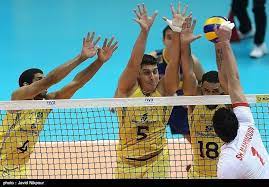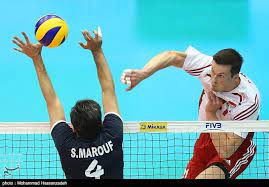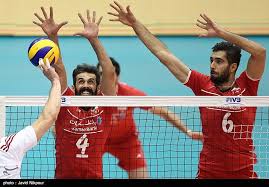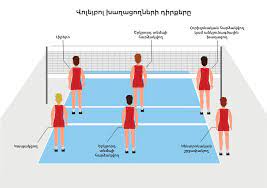Introduction
As a volleyball lover or player, we may have a question like when can volleyball players switch positions? Right? Switching positions in volleyball isn’t just a rule; it’s a smart move that can change the game. Teams that get good at it have an advantage. In this article, we will discuss in detail when can volleyball players switch positions, the basic rotation system and other terms related to it.
When Can Volleyball Players Switch Positions?
Volleyball players switch positions each time their team wins the serve from the opposing team. Volleyball players follow a rotation system with players moving clockwise each time their team wins the serve from the opponents.
During these rotations, players have to stay in their assigned positions. According to the rules, they can only switch positions after their team scores a point. So, during the back-and-forth of the game, each player has to stick to their specific area on the court.
To keep things fair and organized, players switch positions right after a point is scored. This rule helps ensure that player positions on the court are distributed in a strategic and orderly way, adding to the overall flow of the game.

Basic Rotation System in Volleyball
Volleyball teams are divided into six positions, numbered 1 through 6, with each player occupying a specific spot on the court.
The players must rotate in a clockwise direction when viewed from above, meaning each player moves to the next position to their right after their team wins the serve or earns a side-out.
Serving Position (Position 1)
The player in the back-right position starts as the server (Position 1) at the beginning of a set. After serving, this player moves clockwise to the next position, and the rotation continues.
Clockwise Movement
After each rally, the team that wins the point rotates in a clockwise direction.
The player who served from the back-right (Position 1) moves to the front-right (Position 2), the player from Position 2 moves to Position 3, and so on.
The player in the front-left (Position 4) moves to the back-left (Position 5), and finally, the player in the back-left (Position 5) moves to the back-right (Position 6), completing the rotation.
Serving Order
The rotation order ensures that players take turns serving, and it helps distribute the players’ skills and strengths strategically throughout the set.
The serving order is crucial in maintaining a balanced and effective team, allowing each player to contribute in various roles throughout the match.

Starting Positions
A volleyball team consists of six players, divided into two rows: front row and back row.
The three front-row players are typically positioned close to the net, with one player at the net (the middle blocker), one on the left side (outside hitter), and one on the right side (right-side hitter).
The three back-row players are positioned farther from the net, with one player in the left back position (left back-row defender), one in the middle back position (middle back-row defender), and one in the right back position (right back-row defender).
The player in the right back position is often the team’s setter, responsible for setting up offensive plays.
Rotation
Rotation occurs when a team wins the serve from the opposing team.
The player in the right back position (RB) rotates to the front right position (FR), becoming the new right front player.
The other players also rotate clockwise. The front-row players move to the back row, and the back-row players move to the front row.
After rotation, the team maintains the same order of positions (setter, outside hitter, middle blocker, right-side hitter, right back-row defender, and left back-row defender), but each player shifts to a different row.
Positional Faults in Volleyball
Positional faults in volleyball are blunders that players make when transitioning between positions on the court. It’s like when someone doesn’t hustle to the right spot fast enough or when there’s a mix-up in communication during these transitions.
These slip-ups can leave gaps in our defense or mess up our offensive game plan. Another common mess is when players don’t follow the right order of rotations, causing confusion and throwing off the whole team’s coordination.
So, any time we don’t stick to our assigned positions or the planned sequence, it’s a positional fault. To avoid these mishaps, we’ve got to communicate well, move quickly, and stick to the playbook for positions. That way, we can keep our team tight and organized on the volleyball court.

Rotational Faults in Volleyball
Rotational errors in volleyball are blunders that happen when players mess up the order of who stands where after winning a point. The game has this clockwise rotation thing going on, and if players don’t move in the right order, it’s a problem.
It could mean someone ends up in the wrong spot, or the team violates the rotation rules. These errors can cost us points, mess up our plays, and throw the whole team off balance. It’s like a dance where everyone needs to know their steps.
To avoid these hiccups, we focus on clear communication, staying alert, and sticking to the game plan for rotations. That way, we keep the flow smooth and make sure everyone’s in the right place at the right time during the match.
Watch This Video Featuring Volleyball Rotations
Conclusion
In summary, changing positions in volleyball isn’t just a rule to follow – it’s a smart move that can impact who wins the game. Teams that know how to do this well have an advantage. They use it to play to their strengths, adjust to what the other team is doing, and make sure their defense and offense are strong.
If you love volleyball, understanding these moves makes the game even more interesting. It shows off the smart thinking and teamwork that makes volleyball games so exciting.
When you rotate in volleyball do you change positions?
Yes, when you rotate in volleyball, players shift positions clockwise. Each player moves to the next spot on the court, maintaining the same general formation but adjusting their position to continue the game.
When can you break rotation volleyball?
In volleyball, you can break rotation when the opposing team serves the ball, allowing players to move and switch positions. However, doing so during the serve can lead to a rotation fault and a point for the other team.
Where do you put your weakest player in volleyball?
In volleyball, the placement of the weakest player varies. Coaches consider individual skills, utilizing players strategically based on strengths. There isn’t a fixed position; it depends on the team’s strategy and the player’s abilities.
What is the middle position in volleyball?
In volleyball, the middle position is held by the middle blocker, situated at the front and center of the net. They play a key role in blocking and executing quick attacks with the setter.
What is position 7 in volleyball?
In volleyball, position 7 typically refers to the back-right position in the rotation. Each player is assigned a specific number based on their position, and position 7 is commonly associated with the back-right player on the court.
